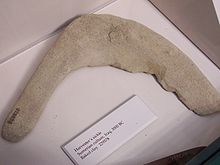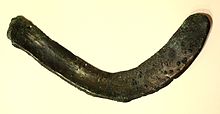Sickle (tool)
The modern sickle is a tool for cutting small amounts of grain and grass . It consists of a forward tapered, concave curved blade (usually made of steel ) with a wooden handle. It differs from the scythe in that it has a smaller blade and a shorter handle. Grass sickles are short but very strongly curved.
History of the term
The word Sichel is borrowed from the Latin sicilis “sickle”, which is probably a noun from the Latin secare “cut” , with Old High German sihila , Middle Dutch sekele , Old English sicol . The term Hippe for sickle knife as a symbolic tool of death, reconstructed in pre-German * hæbjon , refers to non-Romanesque terms such as Greek κόπτω (kópto) "I strike", Lithuanian kirsti "felling", Russian копа́ть (kopát ') "chop, hew, dig" .
History of the item

Along with the harvest knife, the sickle is one of the oldest agricultural implements. The oldest sickles were found in the Levant , where they were already used in the Proto- Neolithic to cut off wild grain or grass. The “sickle shine” that characterizes use is not only created when cutting grain (including grass, reeds or leaves). They consisted of bent pieces of wood or antlers into which a few flint blades were glued with pitch , asphalt or burnt lime . Sickles have been made from bronze since the Middle Bronze Age. Axel Steensberg distinguishes between two sickle shapes :
A) the hook sickle (angular sickle), in which the sheet just emerges from the booklet so that the emphasis is on one side
B) the balanced sickle, in which the sheet bends at right or obtuse angles on the handle so that the weight is evenly distributed on both sides
Type B originated in the La Tène period , spread among the Romans and became generally accepted in the Middle Ages.
In Szegvár -Tüzköves ( Csongrád county ) a seated clay statuette of a man with a sickle over his shoulder was excavated. He comes from the Tisza culture and was interpreted by the excavator as a "sickle god". In ancient Greece , the sickle was the symbol of agriculture and thus an attribute of the goddess Demeter .
Flint sickles
The clearly asymmetrical, bifacilely retouched sickles are among the most prominent Danish flint artifacts. They date to Period II and III of the older Bronze Age and are particularly common in northwest Jutland . There are a number of sickles ( Danish flintesegle ) from Ærø , but the one from Kallehave is absolutely splendid. It has a length of 17.5 cm. It is a miracle that despite the plowing, it survived for 4,000 years. A comparable example from "Baiersdorfer Plattensilex" (12.6 cm long) was found in 2016 on the Leubinger Fürstenhügel.
Symbolic use
heraldry
The sickle can be found as a common figure in heraldry in many municipal coats of arms . The position and direction of the blade must be reported in the description . Otherwise all heraldic colors are possible for the tinging . The stem is often colored in gold. The sickle is said to represent agriculture in the coat of arms and a grain sheaf often accompanies the coat of arms figure. The sickle in the coat of arms must not be confused with the vine knife .
Political symbolism

As a political symbol, it is shown together with the hammer in the coat of arms and also in flags. Crossed with each other, hammer and sickle are a symbol of the workers-and-peasants state in real socialism , e.g. B. on the flag of the former Soviet Union .
In the national anthem of Catalonia des Els Segadors (German: The reapers) - it goes back to an old Catalan folk song - the revolt of the reapers , Guerra dels Segadors , from 1640-1652 against the Habsburg King Philip IV of Spain (1605– 1665) and its prime minister, the Count of Olivares (1587–1645). In their refrain : Bon cop de falç , bon cop de falç defensors de la terra, bon cop de falç (German. A good blow with a sickle, a good blow with a sickle, defender of the country, a good blow with a sickle! ) a sickle is mentioned several times as a possible weapon.
literature
- Berrit Valentin Eriksen: Swan song about the stone handicraft - masters and those who cannot - Denmark's early metal age stone technology In: Archäologische Nachrichten aus Schleswig-Holstein 2011 ISBN 978-3-529-01433-8 S 6 ff.
- Jens Lüning: Stone Age farmers in Germany - agriculture in the Neolithic. University research on prehistoric archeology, Volume 58. Bonn, Habelt 2000, ISBN 3-7749-2953-X .
- Hildegard Quitta: Medieval sickles from Leipzig. In: Research on Prehistory and Early History Volume 1 (1955), pp. 148–153
See also
Web links
Individual evidence
- ^ Etymological dictionary of the German language, 25th edition, Berlin / Boston 2011, sv Sichel, Hippe
- ↑ Manfred R. Behm-Blancke, Johannes Boese , To late Chalcolithic harvesting devices in northern Syria and southeastern Anatolia. In Rainer Michael Boehmer and Joseph Maran (eds.), Lux Orientis. Archeology between Asia and Europe. Festschrift for Harald Hauptmann on his 65th birthday . Rahden, Leidorf 2001, 27-37
- ↑ Axel Steensberg: Ancient Harvesting Implements. A study in archeology and human geography, Nationalmuseets Skrifter, Arkaeologisk-historisk Raekke Volume 1, Copenhagen 1943
- ↑ Svend Hansen , On the size format of Neolithic figural sculpture. In: Rainer Michael Boehmer and Joseph Maran (eds.), Lux Orientis. Archeology between Asia and Europe. Festschrift for Harald Hauptmann on his 65th birthday . Rahden, Leidorf 2001, 181-186
- ↑ József Csalog The anthropomorphic vessels and sculptures by Idol Szegvár-Tüzköves. Acta Archaeologica Hungarica 11 , 1959
- ↑ AiD 02/2017 p. 53




